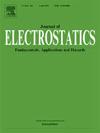Influence of polarity reversal on interfacial charge formation in multilayer dielectric insulation
IF 1.9
4区 工程技术
Q3 ENGINEERING, ELECTRICAL & ELECTRONIC
引用次数: 0
Abstract
In this paper, the effect of the polarity on the formation of the interfacial charge between two dielectrics has been investigated. A sandwich structure constituted by two dielectric films Polyethylene (LDPE) and Fluorinated Ethylene Propylene (FEP) was subjected to high DC electric field, and the measurement were performed in case of polarization and depolarization. For reversed polarity effect, the experimental results show that the space charge profiles measured at different voltage polarities are not symmetrical, in particular, has observed the following behavior in dielectric interface configuration Cathode (Al)/LDPE/FEP/Anode (SC) under a positive polarity: negative charge accumulates at the dielectric interface LDPE/FEP.
The anode configuration (Al)/LDPE/FEP/Cathode (SC) under a negative polaritys: a positive charge accumulates at the dielectric interface LDPE/FEP.
For the same dielectric inversion of polarization does not give the same amount of interfacial charge, because the quantities of positive interfacial charges (holes) and negative (electrons) depend on the injection electrode (Al). The existence of the interfacial charge is positive or negative.
极性反转对多层介质绝缘中界面电荷形成的影响
本文研究了极性对两介质间界面电荷形成的影响。将聚乙烯(LDPE)和氟化乙烯丙烯(FEP)两层介质膜置于高直流电场下,并对其极化和退极化情况进行了测量。对于反极性效应,实验结果表明,在不同电压极性下测得的空间电荷分布是不对称的,特别是在正极性下阴极(Al)/LDPE/FEP/阳极(SC)的介电界面配置中,观察到以下行为:负电荷在LDPE/FEP的介电界面处积累。负极下的阳极(Al)/LDPE/FEP/阴极(SC):在LDPE/FEP的介电界面处积累了正电荷。对于相同的介质,极化反转不会给出相同数量的界面电荷,因为界面正电荷(空穴)和负电荷(电子)的数量取决于注入电极(Al)。界面电荷的存在是正的或负的。
本文章由计算机程序翻译,如有差异,请以英文原文为准。
求助全文
约1分钟内获得全文
求助全文
来源期刊

Journal of Electrostatics
工程技术-工程:电子与电气
CiteScore
4.00
自引率
11.10%
发文量
81
审稿时长
49 days
期刊介绍:
The Journal of Electrostatics is the leading forum for publishing research findings that advance knowledge in the field of electrostatics. We invite submissions in the following areas:
Electrostatic charge separation processes.
Electrostatic manipulation of particles, droplets, and biological cells.
Electrostatically driven or controlled fluid flow.
Electrostatics in the gas phase.
 求助内容:
求助内容: 应助结果提醒方式:
应助结果提醒方式:


